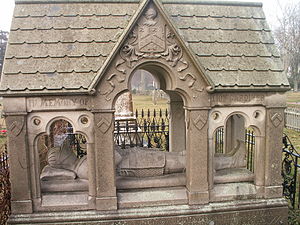The Story of Lion Gardiner: The Hamptons' First English Settler

Surely the strangest tomb in the ancient graveyard by Town Pond in East Hampton is the statue of a man, made entirely of stone, lying on his back atop a rectangular slab in full medieval armor. He wears a helmet and holds under his chin the handle of a long sword, its blade leading down past the metal fringe of his cape to his boots.
This is Lion Gardiner’s resting place. Born in England, he became the first English settler in what is now the Hamptons. And yes, he fought battles against his enemies while dressed in this medieval armor. He lived from 1599 to 1663.
How this all came to happen is quite a story. Here it is, pieced together from several sources.
Gardiner was raised in England in a family suffering persecution for their religious beliefs. Fleeing to the Netherlands as a young man, he apprenticed to a fort builder and soon was building military forts for the Dutch, who were fighting to overthrow their Spanish rulers. There, he prospered. He married a Dutch woman, had children, purchased a large home and plied his trade.
In 1635, Gardiner received a commission from the English King Charles I to leave the Netherlands and go to the new world where there was a need to build a fort at the mouth of the Connecticut River. The fort, when manned by British soldiers, would then be able to protect merchant ships from being attacked by the warlike Pequot tribe as they entered or left. Gardiner was to be paid 100 pounds a year for three years to build this fort. This was quite a considerable sum. And so, Lion Gardiner, 34, sailed across the ocean with his wife and children aboard the 25-ton Batchelor where, on arrival in Boston, he was to be met by 100 workmen to begin building the project. Instead of 100, there were only two. Gardiner started the project anyway.
The Pequots held off during the building of the first part of the fort, but soon thereafter raided the place, killing cows and sheep and stealing vegetables from the little temporary farm run by Gardiner and his wife. Gardiner appealed for soldiers, and a few arrived so that during the night when the raiders came, they could be driven off. Gardiner and his men prevailed because they had pistols and blunderbusses as well as swords. He was also fighting in defense of his family, in harm’s way.
During these frequent skirmishes, Gardiner wore the suit of armor that had been made for him when he was building forts in the Netherlands. Although he never fought wearing it there, he was given it as an officer in the Dutch army, and when he left to come to America, he wisely packed it up and took it with him. Such a suit of armor could ward off the slings and arrows of the Pequots. Nevertheless, during one encounter, he was wounded in the thigh, and had to be treated for it.
When the fort was nearing completion three years later, the English lords in Boston refused to renew Gardiner’s contract and continue to pay him the 100 pounds a year he had been receiving. They had some minor complaints about it, most notably that it took longer than he said it would.
Gardiner was embittered by this, but soon was cheered when, in 1639, the Indian chief Wyandanch of the Montaukett tribe on Long Island offered to sell him a small island that sat in a bay offshore of what is now Amagansett. Two years earlier, Wyandanch’s daughter, celebrating her wedding on this island, was kidnapped by the Pequots during the ceremony and taken back to Connecticut. Wyandanch, distraught, went to Connecticut and met with Gardiner at the fort, now called Old Saybrook. He asked Gardiner if the English settlers could protect his tribe from the Pequots., and if he could get his daughter back. Gardiner tried, meeting with the chief of the Pequots, but was unsuccessful. Nevertheless, Gardiner and Wyandanch became close, and soon thereafter, when the English, joined by some of the other peaceable tribes, defeated the Pequots, Wyandanch offered to sell Gardiner the island. Here, Gardiner could bring his family and servants, build a farm and spend the rest of his days in peace.
Years later, when Gardiner passed on, he left the island to his children. It remains in the Gardiner family to this day, five centuries later.
In 1640, one year after Gardiner moved to the island, however, New England settlers from Lynn, Massachusetts landed on the north shore of Long Island 30 miles west of Gardiner’s Island and there, with the help of friendly Shinnecock Indians, started a colony they called Southampton. Settlers in Southampton soon migrated eastward, first establishing Bridgehampton in 1644 and then East Hampton in 1648. Lion Gardiner became very active in his later years as the head man of the English colony in East Hampton.
In his later years, Lion Gardiner wrote a book about the war he had lived through. The war was vicious and awful — much as wars today are vicious and awful — and he was glad to be done with it. He wrote his book longhand, with quill and ink, a single copy called Relation of the Pequot Warres, and sent it off to Connecticut Gov. John Winthrop for safekeeping. It was not kept very well. It was thought to have burned in a fire in the governor’s mansion a few years later. But 300 years later, the book was found in the library of the later governor of Connecticut, Jonathan Trumbull. And a photostatic copy of it is in the East Hampton Library today where, not long ago, I read it.
Lion Gardiner died in 1663, and hundreds of settlers along with many Indians now living in Southampton, Bridgehampton and East Hampton mourned and prayed for his soul. Thus was built this stone statue of him, on his back, wearing that stunning armor he’d brought with him to the new world.
Gardiner wrote, “Oh yes, I fear I shall be in the country again … repairing cities and towns, making strong forts and preparing all things needful against a time of war, like Solomon. I think the soil has almost infected me but what they or our enemies will do hereafter I know not. I hope I shall not live so long here … else I might be in fear to see and hear what I think … ere long will come upon us.”
— Relation of the Pequot Warres




